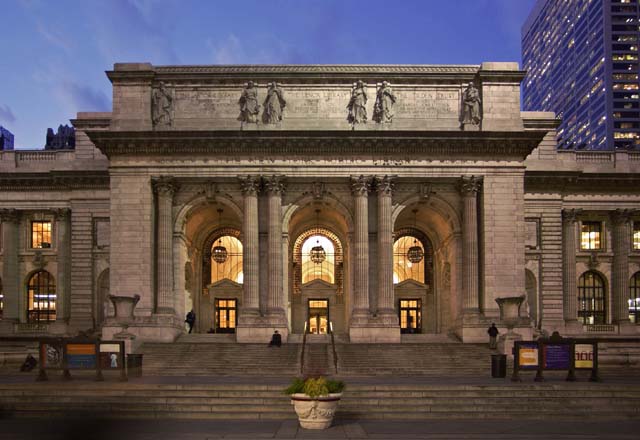
The New York Public Library – A Tribute
As an immigrant writer from India, I well remember my first day in New York City. Overwhelmed by the enormous skyscrapers, fast moving crowds and nonstop traffic on Fifth Avenue, I suddenly came across an ocean of calm, an iconic, strikingly beautiful Beaux-Arts building at a height, with cascading stairs below it. At the foot, on either side were two life-size handsome marble lions.
On a golden afternoon with an improbably blue sky that looked as if it had been painted on by a happy artist, people decked in the colors of spring rushed by. Yet many stopped to relax on the granite stairs, to pat the gentle, stoic lions, to take a photo. I had just bought a copy of ‘Writer’s Market’, the bible for aspiring writers, and sat down on the stairs to browse the possibilities for a writer in America.
My seating spot turned out to be appropriate for this building was none other than the New York Public Library (NYPL) which for a hundred years has imparted a love of reading, writing and knowledge to all who come to its doors. The lions, which are the library’s mascots, are named Patience and Fortitude, certainly virtues which are needed to succeed in America.
Generations have come to this landmark building, which is officially known as the Stephen A. Schwarzman Building, for access to material encompassing all eras. NYPL has an unbelievable 65 million items, including 14 million books. Its treasures include rare manuscripts, maps, records, DVDs, CDs and rare photos. It’s probably the most comprehensive library collection in the world which is open for free use by the public.
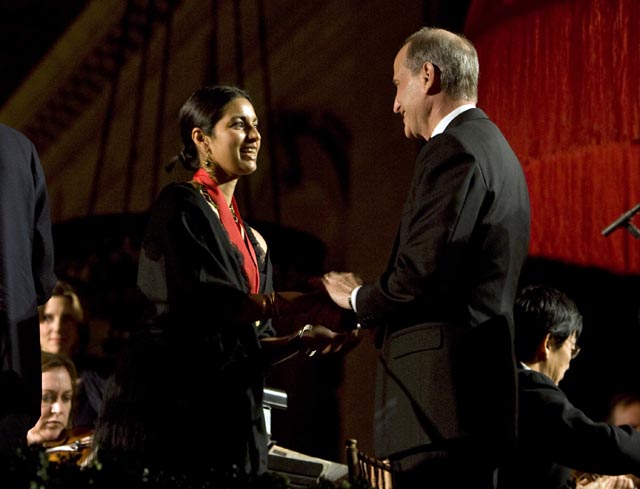
The Stephen A. Schwarzman Building is part of The New York Public Library, which consists of four major research libraries and 87 branch libraries located in the Bronx, Manhattan, and Staten Island. The collections include priceless ancient rarities in the Rare Books and the Manuscripts and Archives divisions to current newspapers from all over the world. It is truly global for over 1,200 languages and dialects, ancient and modern, are represented in the collections.
“We are very committed to spreading knowledge, inspiring lifelong learning and strengthening our community,” says Ann Thornton, Acting Andrew W. Mellon Director of the New York Public Libraries. “We are still very much about collecting, preserving and making things accessible to people.” This building holds the Library’s rich and diverse collections in the humanities, social sciences, and special collections.
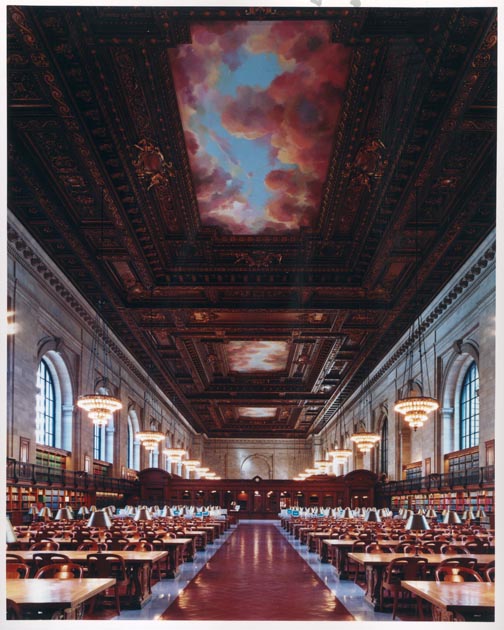
These non-circulating graduate-level collections were initially formed from the consolidation of the Astor and Lenox Libraries, and have evolved into one of the world’s preeminent public resources for the study of the humanities – covering everything from anthropology to world history to literature.
The NYPL collections have been organized into more than 100 major topics, ranging from US history to Immigration to Gay and Lesbian studies to women’s studies. The library also owns key collections of photographs totaling 400,000 images, and over 200,000 works of art, and dozens of illuminated manuscripts. In fact, so vast are its collections in some areas that entire libraries have been created to hold these items: The New York Public Library for the Performing Arts (LPA) at Lincoln Center, The Schomburg Center for Black Culture in Harlem, and the Science, Industry and Business Library (SIBL) in Manhattan, which is a world-class center for providing free business support to all New Yorkers.
Besides the main Stephen A. Schwarzman Building, there are 88 branch libraries in New York City and its boroughs, which interact with communities on a daily basis, lending books, DVDs and audio books, organizing talks and movies and nurturing communities.
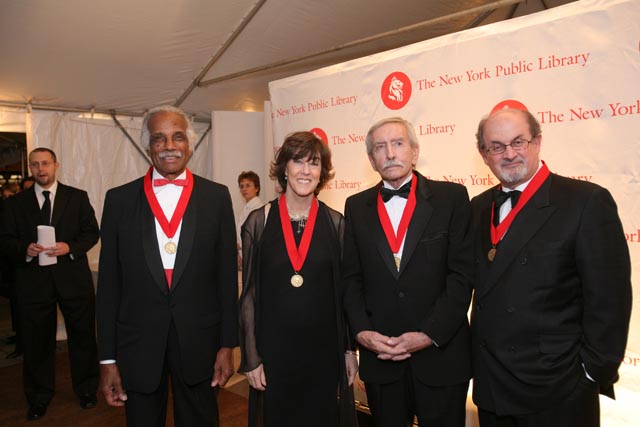
“Our goals are to create new thinkers, new readers, more writers, scholars, and artists – people who essentially create new content,” points out Thornton. “So the ultimate goal of all of this is that some new creative works, or works of scholarship or entrepreneurship even will come out of what we’ve collected – it’s really to advance knowledge and to strengthen society.” With a view to that, the Library is wonderfully open to seeing that all its research resources are fully shared with those who need them.
It provides special rooms for writers who are working on projects which need access to research materials. In the hustle and bustle of the city, they get a cubicle and a bookshelf and even a shared computer to work on their project. They can also bring in their own laptop and can always be assured of a personal consultation with the librarian on how to do the research.
The NPYL has a mission to encourage future researchers and thinkers so have recently implemented travel scholarships which provide travel assistance to writers from different countries who need to use the research facilities of the library for their projects. In fact, the people who have used the facilities for their ongoing research include everyone from choreographers to professors, writers, translators and social entrepreneurs.
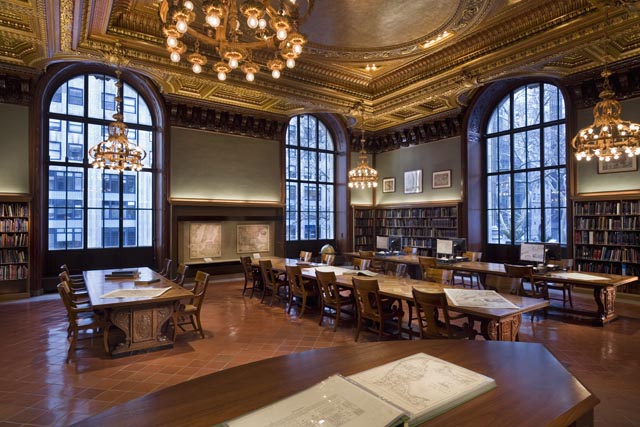
“What an ideal research librarian does is provide advice, and is a gateway into a subject, maybe even provide an angle the researcher hadn’t even thought of,” says Thornton. “We add value to people’s research and help them to work smarter, to work better, and to separate the wheat from the chaff.”
Many of the librarians play several different roles to make the subject come alive for visitors. Jessica Pigza, a librarian specializing in rare books, also teaches classes on the history of handmade books and co-hosts Handmade Crafternoon, a monthly series which connects library users and craftspeople in hands-on projects. She says, “I’m enthusiastic about sharing what we collect and preserve in new contexts, and I see great potential in devising ways to make our resources more fluid and more accessible in places where people congregate virtually.”
There is something for everyone and the library and its branches provide opportunities for people to learn new skills, particularly technology. This is a great boon in the harsh economic climate – it is estimated that 23 percent of the people who come to the library today are out of work. So the library becomes a place for them to improve their skills and provides them training and job leads from career coaches and financial specialists.
Many are the entrepreneurs who have started their small businesses with help from the SIBL or the Bronx Library Center, both equipped to handle people looking to jumpstart their careers. “It’s an incredible way to advance yourself, and it’s the starting point for many people because of its free aspect,” says Thornton. New York is a city of immigrants and many are the people who have benefited from the library’s reading and writing classes as well as English classes. School teachers use the research collection to create curriculum guides, and talks, exhibitions and classes make learning a pleasurable pursuit.
There is homework help for students, and recorded and Braille titles for visually impaired visitors. There are also special services for homebound people, non-English speakers, as well as for those who are homeless or are disabled.
Is the role of library changing in this era of high technology? Are books going to die out? That does not seem likely as the library has embraced technology – its resources are available on the web to a worldwide audience. All Library locations offer free wireless access (Wi-Fi) as well as public access to the Internet, hundreds of electronic databases, word processing and software applications through an electronic reservation system. Over 800,000 searchable images are in its digital galleries and so the library is now going into homes, and people can download material onto their e-readers, Smart phones and laptops, and now the IPAD. It is estimated that www.nypl.org, receives 28 million visits annually from more than 200 countries.
“People often think of electronic surrogates as replacing physical books, but the opposite can also be true,” says Micah May, Director of Strategy Office of Strategic Planning. “Use of our special research collections has been rising, largely because of better digital discovery and some experts claim that people who read e-books are also reading more physical books. We are doing lots of things in the digital space that I think are symbiotic with the physical and those are the initiatives that excite me most.”
The NYPL is not an isolated Ivory Tower but a life and blood space because it engages the community and becomes a part of their lives. The stately marble edifice is often full of laughing children and mothers pushing strollers because the children’s circulating room is in this building. It is also the home of the real Pooh which belonged to Christopher, the son of A.A. Milne who created Winnie the Pooh. So visitors to the NYPL get to see not only Winnie the Pooh but also Tigger, Eeyore, Piglet and Kanga.
It’s all about living and life, with Live from NYPL programs in the Celeste Bartos Education Center which has an auditorium and a theater. This elegant room has seen many a soiree including the annual Library Lions Gala where noted artists and writers are honored, including authors Salman Rushdie and Jhumpa Lahiri.
This room is also transformed into a celebration space and many New York weddings have been held here. The marble library building is embedded in the greenery of Bryant Park which is always full of families and workers taking a break from office routine. What many people don’t realize is that below them under the surface of the park lie millions of books!
“The park is on top of a stack extension,” explains Thornton. “Many years ago we excavated the park with the co-operation of the city and we built a stack extension which holds one and a half million books and the material, except for the rare books, travel on a conveyor belt to the main library.”
People walk and talk in the park as children play ball – and below the green grass sleep the rare books from decades past. And so books and people are juxtaposed and a part of each other’s existence. And that’s the way it should be.
© Lavina Melwani
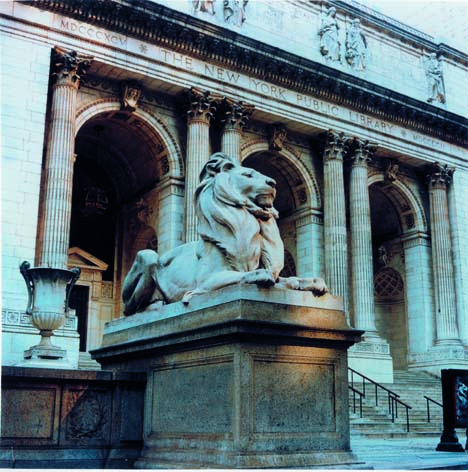
The Library Lions
Patience and Fortitude, the world-renowned pair of marble lions that stand proudly before the majestic Beaux-Arts building at Fifth Avenue and 42nd Street in Manhattan, have captured the imagination and affection of New Yorkers and visitors from all over the world since the Library was dedicated on May 23, 1911.
Called “New York’s most lovable public sculpture” by architecture critic Paul Goldberger, the Lions have witnessed countless parades and been adorned with holly wreaths during the winter holidays and magnificent floral wreaths in springtime.
They have been bedecked in top hats, graduation caps, Mets and Yankee caps, and more. They have been photographed alongside countless tourists, replicated as bookends, caricatured in cartoons, and illustrated in numerous children’s books. One even served as the hiding place for the cowardly lion in the motion picture The Wiz
(Source: NYPL)
(This article first appeared in Housecalls magazine)

8 Comments
Pingback: 16 Libraries You Have To See Before You Die | Viral News Worthy
Pingback: Love to Read? 16 Libraries You Must See! | Behind the Scenes Geek
Hi Lavina,
My experience so far has been that reading standard among the younger generation has definitely gone down, while at the same time, the cost of buying books has gone up! 😀
This is what prompted me to start an online book renting model. People just visit my website and choose the books they want to read and we get them home-delivered. Do check it out.
I loved the article about NYPL. I’ve been there in 1995 and enjoyed the opportunity to visit it. When I visit such a great place, I feel we have a chance of intimacy with our past.
Hello Anne, as you must have realized, I’m a big fan of the NYPL and also the many public libraries in the suburbs. It must be really satisfying teaching adults to read and write – it’s like opening up a whole new world for them. Yes, it would be a shame to cut such a massive amount – the public libraries serve so many different social needs – it’s more than just books.
Ridhi, thanks for your comments. Yes, I’m exploring all the different ways to read – and would love to do a piece on that! What’s happening in India?
When I lived there, there weren’t very many public libraries with the latest books. What are the options for people, besides buying the books?
Thanks for commenting on the many wonders of the NYPL!
I teach adults to read and write at the Bronx Central Library (Center for Reading and Writing) and it is a thrill! I love all the “ah-ha” moments we share.
The idea that NYC plans to cut $37 million from the budget of the NYPL is sacrilege!
Hi Lavina..I have been following your blog for a while now.
Being an avid reader and worshiper of books, I loved this particular post. With the advent of internet, reading habits have definitely gone down – I can definitely vouch for the Indian market. Maybe you should write something about traditional books vs e-book readers like kindle?